
William Nigh’s Black Dragons (1942) marked the third of Bela Lugosi’s nine films for schlock producer Sam Katzman at Monogram Pictures. It is possibly the screwiest of the lot, which is a claim of no little weight. Moreover, it was one of the earliest WWII propaganda films—going into production little more than a month after Pearl Harbor. It looks it, too. Like most of the Monogram Nine, it’s largely confined to one setting—and one that looks suspiciously like redressed sets from Invisible Ghost (1941)—and a bare minimum of exteriors. In fact, most of the exteriors involve people getting in and out of taxi cabs (Lugosi arrives in the film in one being driven by Leo Gorcey’s father, Bernard). The “moving” shots of people riding in cabs take place at night and the movement of cars behind them consists of a parked car turning its lights on and off. Yes, it’s that kind of film.
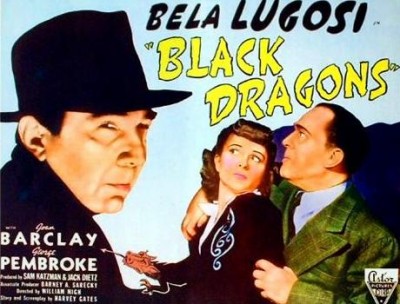
The plot involves a group of American industrialists (why this includes an M.D., I do not know) who are in reality Japanese saboteurs. These are forward thinking fellows to judge by the stock footage of their nefarious activities, since they appear to have been behind the riots at Rudolph Valentino’s funeral in 1926. So why don’t they look even slightly Japanese? Ah, that’s part of the plot. Just as they’re about to flee the country—following some terrific dialogue like, “Well, I wish we could blow up more ammunition dumps before we have to leave,” and occasionally muffing their lines (with no reshoot)—a mysterious figure, Monsieur Colomb (Lugosi), arrives on the scene and evils start befalling these boys—and their corpses keep showing up on the steps of the Japanse Embassy (boldly emblazoned with “CLOSED”). Despite the fact that everything that happens is related to Dr. Saunders’ (George Pembroke) house where Colomb has taken up residency—holding Saunders with some unspeakable power that keeps the doc confined to his room—no one seems quite able to pin anything on anyone. Certainly G-man Richard “But you can call me Dick” Martin (the Lone Ranger himself, Clayton Moore) can’t. This, of course, leaves Colomb free to bump off Japanese spies right and left (though at the end of the film, the FBI takes credit).
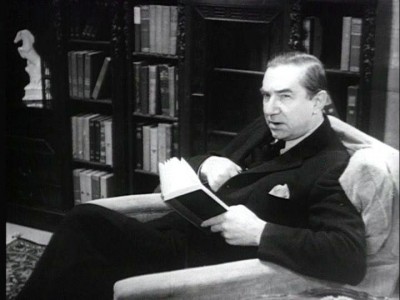
In case anyone cares, I won’t give away the “surprise” ending, but it’s a honey—and near as I can tell, the FBI is responsible for criminal negligence by letting the wounded Colomb bleed to death while the explanatory flashback goes on. All in all, Black Dragons is deliciously silly with some magnificently dopey dialogue. Consider the scene where Alice Saunders (Joan Barclay) overhears Colomb strangling a Japanese spy, but finds only Colomb when she investigates. “I heard a sound like a body falling,” she tells him. “Oh, I was stumbling, I was awkward,” Colomb tells her. “Yes,” she counters, “but there were gurgling sounds.” “Oh! I was humming. Is my voice as bad as that?” alibis Colomb (with his victim trussed up in the drapes all the while). At the time of its release, Lugosi claimed the film was the “most terrifying” movie he’d ever made. In what sense was not made clear.
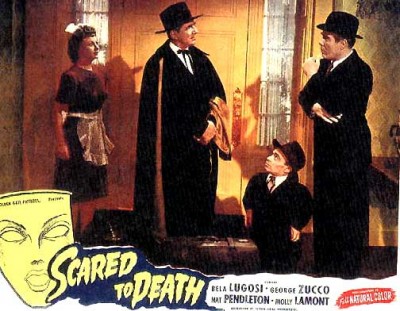
Christy Cabanne’s Scared to Death (1947) is something else altogether, though no one has ever successfully determined what that something else is. It has the distinction of being Bela Lugosi’s only color starring film. The color process is called “Natural Color,” but is in reality Cinecolor—a two-color process that looks a lot like a more garish and stable version of the old two-strip Technicolor, which had been phased out in 1933. The biggest drawback to this is that Scared to Death is a picture all about a green mask—and guess what color Cinecolor was lousy at reproducing? Uh huh. So what you have is a movie with a lot of folks talking about this “green mask” that looks blue. (The posters are the only place it actually showed up sort of green.)
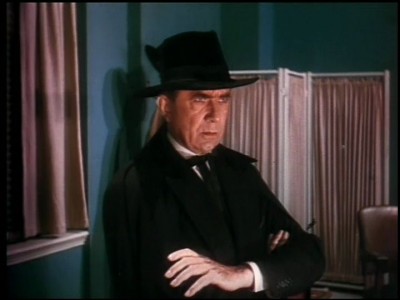
Despite being in color and boasting a poverty row dream cast—Lugosi, George Zucco, Nat Pendleton, Douglas Fowley, Joyce Compton, Angelo Rossitto—Scared to Death is, if anything, even cheaper than the Monogrammers had been. It was the sixth of sixth movies made by Golden Gate Productions and distributed by Screen Guild—best known at the time for re-issuing films that had mostly fallen into the public domain. It’s all pretty appropriate for Scared to Death, but it’s also embarrassingly tacky for the hapless performers—all of whom were clearly in need of the job, and all of whom were giving their all. Whatever else may be said about Scared to Death, truly can it be said that the cast does not slack. And if they were actually as perplexed by the proceedings as they had every reason to be, they never show it.

But there’s something else about Scared to Death—the question of intent. It is hard to believe—even within the weird world of poverty row—that this movie got this way by accident. It may just be that the film was meant to be an aburdist joke. I like to think that Luis Bunuel had a hand in it—and he was hanging around Hollywood about that time. Plus, there’s a magician and his dwarf sidekick at the beginning of Bunuel’s The Milky Way (1967) who bear a striking resemblance to Lugosi and Angelo Rossitto here. Nonsense? Well, perhaps, but can you disprove it? No, you cannot. And look at those faces—Lugosi, director Cabanne, screenwriter Walter Abbott—in the publicity photo to the right. Don’t they look like they’re up to something? Exactly.
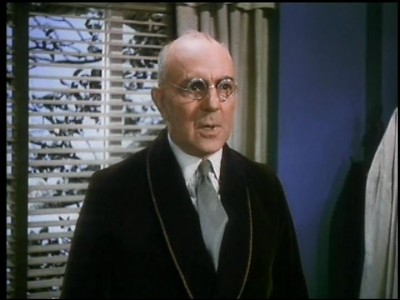
You see, everything about Scared to Death is strange—from the weird dialogue to the incoherent plot (told by a corpse on an autopsy table!) to the ghastly production design to the mannered performances. No, this isn’t just the oddness of Lugosi in a cape, slouch hat and Col. Sanders tie as a dishonest stage magician—and escapee from an insane asylum. There’s more here than that to wonder about. Some of it—like Lugosi telling the maid (Gladys Blake), “My dear girl, if I allowed myself to be announced, I doubt I would be received anywhere”—is obviously meant to be funny. But what to make of lines like, “Nevertheless, Doctor, the way you were described to me and the way this place was described to me, I am certain I am in the right place,” or “Why, Laura? Why are you so opposed to the bandage?” or “I know of only one person who could haved given you that information, and it was my belief—yes, even my hope—that the person was dead”? And what in the hell is an “old anatomical locker?” And why does it include a fake head of a screaming, bug-eyed woman? These are all questions worth pondering—or as Lugosi’s Prof. Leonide would ominously say, “Something to think about.” And there’s more. Much, much more. This is a movie where Douglas Fowley poses the question, “Pardon me, Professor, but didn’t I just see you outside baying at the moon?” You just don’t get that every day.

The whole thing looks like it was made for a buck and a quarter, and apart from the morgue framing story and some shrubbery representing the grounds, it all takes place inside this one house (that has no exterior we ever see). It feels like something you watched on late night TV while drifting in and out of sleep—like something dimly remembered that’s become mixed up with odd dreams. It’s also very much an acquired taste. Personally, I adore it—I even have an original poster for it on my wall—but whether you will…who can ever be sure?
The Thursday Horror Picture Show will screen Black Dragons and Scared to DeathThursday, Nov. 21, at 8 p.m. in the Cinema Lounge at The Carolina Asheville and will be hosted by Xpress movie critics Ken Hanke and Justin Souther.



Before you comment
The comments section is here to provide a platform for civil dialogue on the issues we face together as a local community. Xpress is committed to offering this platform for all voices, but when the tone of the discussion gets nasty or strays off topic, we believe many people choose not to participate. Xpress editors are determined to moderate comments to ensure a constructive interchange is maintained. All comments judged not to be in keeping with the spirit of civil discourse will be removed and repeat violators will be banned. See here for our terms of service. Thank you for being part of this effort to promote respectful discussion.